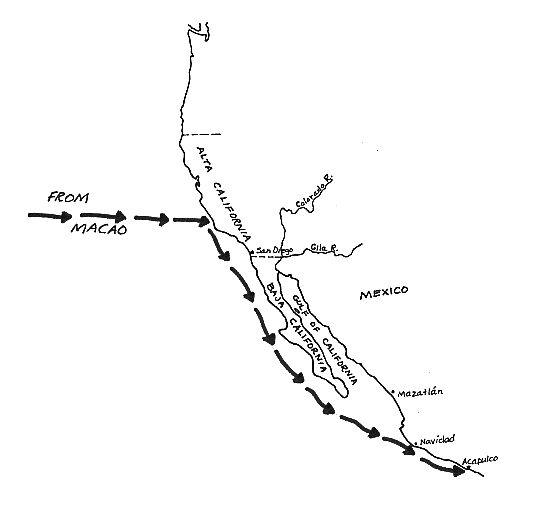| ||||
|
| ||||
|
PEDRO
DE UNAMUNO
and the Manila Galleons
 Lived:
in the late 1500s and early 1600s
Lived:
in the late 1500s and early 1600s
Explored California in: 1587
Exploring for: Spain
Explored: by sea and inland near Morro Bay
Looking for a good harbor along the California coast, Unamuno explored inland to the site of present-day San Luis Obispo.
EARLY HISTORY
Pedro de Unamuno had a reputation as a good navigator. He had served
under Captain Francisco Gali, a skilled pilot in
the service of
BACKGROUND
The Philippine Islands became
part of the Spanish empire about 1565. The Spanish then began to send ships
from New Spain (
The Manila trade was very important
to the economy of New Spain for more than 200 years. The authorities in mainland
In 1584 Captain Gali, on his way back from one of these trips to the
When Gali and Unamuno reached Manila,
in the
Somehow, Unamuno was reported to have plans of becoming a pirate and of conspiring with some Portuguese merchants in Macao, a Portuguese island in the South China Sea. He denied this, but then sailed to Macao despite orders not to do so. There he was jailed and his ships taken from him.
When he got out of jail, he found himself stranded in Macao. He managed to get funds to purchase a small ship. He may have had the help of a Franciscan priest, Martín Ignacio de Loyola, who wanted to get away from Macao.
UNAMUNO’S JOURNEY
Unamuno’s ship was sturdy but too small for a safe crossing
of the rough waters of the North Pacific Ocean. Unamuno and about 40 companions set out anyway in July 1587.
On board was the pilot, Alonso Gómez, two other
Franciscan priests besides Father Martín, a few
sailors, some Spanish soldiers, and a few Luzon natives from the
The ship’s log from this voyage shows that it was a rough one. The crew had to keep making repairs to the ship. After more than three months of wet, cold weather, they saw the coast of California. Their first landing was on October 18 in a bay that they named Puerto de San Lucas, because it was the feast day of St. Luke. This is now called Morro Bay.
Unamuno and a group of soldiers, led by Father Ignacio carrying a cross, left the harbor to explore inland. They spent three days exploring, walking as far as the present-day site of San Luis Obispo. Unamuno reported that the hills were beautiful with oaks and sycamores, and that the harbor he had found was a good one for ships stopping on the way home from Manila. There were freshwater streams, trees for making new masts, and fish to eat. Unamuno also looked around for signs of silver, gold, or other precious metals, but found none.
On a hill overlooking the harbor,
Unamuno took possession of the port and the country
in the name of the king of
The group of visitors were seen by Indians (probably Salinan) living in the area. The exchange between them was hostile, with one of the Spaniards being killed by an Indian arrow. The Indians were forced to retreat by gunfire from the Spaniards. Some Indians were killed and more Spaniards were wounded.
Unamuno left Morro Bay as quickly
as he could. He kept close to land as they sailed south, hoping to find other
good harbors. But the wind was strong and there was fog. The wounded men needed
medicine. So the little ship hurried on south to Acapulco, on the coast of
WHAT HE ACCOMPLISHED
Unamuno’s brief exploration of the land around Morro Bay was the furthest inland that any European had ventured from the Pacific Coast.
LATER YEARS
Though the government in New Spain had wanted this exploration, they paid little attention to it. The bay that Unamuno had charted and named did not appear on any maps in the next years. The galleons coming from Manila did not use it as a harbor. Unamuno’s feat of bringing his small ship safely across the North Pacific and down the coast of California was forgotten.